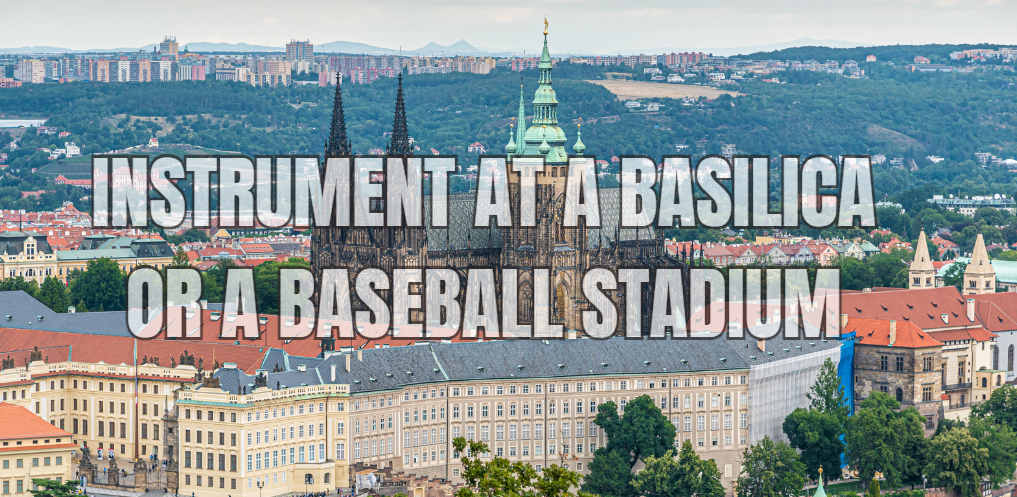When one thinks of a basilica and a baseball stadium, these two places might seem worlds apart—one steeped in religious tradition and solemnity, the other echoing with the cheers of excited fans and the crack of a bat hitting a ball. However, they share a surprising connection through a common element: the presence of a powerful instrument.
The concept of an “instrument at a basilica or a baseball stadium” may sound enigmatic, but it bridges the gap between sacred spaces and arenas of sport through the transformative power of sound.
In this comprehensive exploration, we will delve into the types of instruments that might be found in both a basilica and a baseball stadium, how these instruments function in their respective environments, and the cultural significance they hold. By the end of this article, you’ll have a deep understanding of the role that these instruments play in shaping experiences within these vastly different yet intriguingly similar settings.
Contents
- 1 1. Introduction to the Concept of Instruments in Basilicas and Baseball Stadiums
- 2 2. Historical Overview of Musical Instruments in Sacred Spaces
- 3 3. The Role of Organs in Basilicas: A Symbol of Divine Resonance
- 4 4. Musical Instruments in Baseball Stadiums: Creating the Atmosphere
- 5 5. Comparing and Contrasting the Acoustic Environment
- 6 6. Cultural Significance and Symbolism of Instruments in Basilicas and Stadiums
- 7 7. Technological Innovations in Sound at Basilicas and Stadiums
- 8 8. Case Studies: Iconic Instruments at Famous Basilicas and Stadiums
- 9 9. The Future of Instruments in Basilicas and Stadiums
- 10 10. FAQs About Instruments at Basilicas or Baseball Stadiums
- 10.1 1. Why are organs commonly found in basilicas?
- 10.2 2. What is the significance of the organ in baseball stadiums?
- 10.3 3. How has technology impacted the use of organs in basilicas and stadiums?
- 10.4 4. Are there other instruments used in basilicas and stadiums besides the organ?
- 10.5 5. What does the future hold for instruments in basilicas and baseball stadiums?
- 11 Conclusion
1. Introduction to the Concept of Instruments in Basilicas and Baseball Stadiums
At first glance, a basilica and a baseball stadium serve entirely different purposes, yet they both represent spaces where people gather for collective experiences. A basilica, typically associated with the Catholic Church, is a large and often ornately decorated building used for worship and religious ceremonies. The word “basilica” itself derives from the Latin word “basilica,” meaning a royal hall. On the other hand, a baseball stadium is a modern arena where fans gather to watch America’s pastime—baseball. Despite their differences in function and design, both spaces utilize the power of sound to enhance the experience of those who visit.
The common thread between these two spaces lies in the presence of musical instruments, particularly the organ. The organ, a grand and complex instrument, has found its place in both sacred and secular venues. In a basilica, the organ’s majestic sound fills the sacred space, uplifting the spirit and complementing the liturgical rituals. In a baseball stadium, the organ has traditionally been used to energize the crowd, create a festive atmosphere, and even interact with the players on the field.
Exploring the concept of the “instrument at a basilica or a baseball stadium” allows us to appreciate the versatility of these instruments and their ability to evoke powerful emotions, regardless of the setting.
2. Historical Overview of Musical Instruments in Sacred Spaces
Music has been an integral part of religious ceremonies for centuries, with instruments playing a crucial role in worship and ritual. The use of musical instruments in sacred spaces dates back to ancient times, where they were believed to bridge the gap between the divine and the mortal world. Over time, the organ emerged as the primary instrument in Christian worship, particularly within the grandiose confines of basilicas.
a. The Evolution of the Organ in Christian Worship
The organ’s history is deeply intertwined with the history of Christianity. Originally, organs were used in various settings, including theaters and public spaces. However, by the Middle Ages, the organ had become closely associated with the church. Its powerful sound was seen as a way to amplify the glory of God, and its complexity was a reflection of the intricacy of divine creation.
b. The Spread of Organ Music Across Europe
As Christianity spread across Europe, so did the use of the organ in worship. By the Renaissance, the organ had become a standard feature in cathedrals and basilicas across the continent. These instruments were not only used to accompany the choir but also to play elaborate solos that demonstrated both the skill of the organist and the grandeur of the instrument itself.
c. The Organ in the New World
The organ’s influence extended beyond Europe as missionaries and colonists brought the instrument to the New World. In the United States, the organ became a staple in churches and cathedrals, continuing its legacy as the voice of sacred music. Basilicas in the U.S., such as the Basilica of the National Shrine of the Immaculate Conception in Washington, D.C., house some of the most magnificent organs in the country, continuing the tradition of organ music in religious settings.
3. The Role of Organs in Basilicas: A Symbol of Divine Resonance
The organ’s presence in a basilica is more than just a musical accompaniment; it is a symbol of divine resonance. The instrument’s ability to produce a wide range of sounds, from the softest whisper to a thunderous roar, makes it an ideal tool for conveying the grandeur and majesty of the divine.
a. The Construction and Complexity of Pipe Organs
Pipe organs are among the most complex musical instruments in existence. They consist of thousands of pipes, each producing a different tone. These pipes are controlled by a keyboard (or multiple keyboards) and a set of pedals, allowing the organist to create intricate and layered sounds. The construction of a pipe organ is a feat of engineering, requiring precise craftsmanship and an understanding of acoustics.
In a basilica, the organ is often custom-built to fit the specific acoustics of the space. The placement of the pipes, the size of the organ, and the materials used all contribute to the instrument’s unique sound. The result is an instrument that is not only a work of art but also a powerful tool for worship.
b. The Acoustic Marvels of Basilica Architecture
Basilicas are designed with acoustics in mind. The high ceilings, large open spaces, and reflective surfaces create an environment where sound can travel and resonate. This makes the organ an ideal instrument for these spaces, as its sound can fill the entire basilica and create a sense of awe and reverence.
The architecture of a basilica amplifies the sound of the organ, allowing it to reach every corner of the space. This creates a unique auditory experience for the congregation, where the music becomes an integral part of the worship experience. The organ’s sound can evoke a range of emotions, from peaceful contemplation to overwhelming joy, making it a powerful tool for connecting with the divine.
c. Famous Organs in Historic Basilicas
There are many famous organs in basilicas around the world, each with its own unique history and sound. For example, the organ at St. Peter’s Basilica in Vatican City is one of the most famous in the world. This grand instrument has been played by some of the greatest organists in history and continues to be a central part of the basilica’s liturgical music.
Another famous organ is the one at the Basilica of St. John Lateran in Rome. This organ, with its rich history and intricate design, is a testament to the craftsmanship and artistry that goes into creating these instruments. Each note played on this organ resonates through the centuries, connecting the present-day listener with the rich history of the church.
4. Musical Instruments in Baseball Stadiums: Creating the Atmosphere
While basilicas use the organ to create a sense of reverence and awe, baseball stadiums use music to energize and engage the crowd. The role of the organ in baseball stadiums is one of tradition and entertainment, creating a lively and festive atmosphere that enhances the overall experience of the game.
a. The Role of the Organ in American Baseball History
The use of the organ in baseball stadiums dates back to the early 20th century. The first known use of an organ at a baseball game was in 1941 at Wrigley Field in Chicago. The organ was used to entertain fans before the game and during breaks in the action. It quickly became a staple of the baseball experience, with other stadiums across the country adopting the practice.
The organ’s role in baseball stadiums goes beyond just entertainment; it has become a symbol of the sport itself. The familiar sound of the organ playing “Take Me Out to the Ball Game” is as much a part of the baseball experience as the crack of the bat or the roar of the crowd. The organist plays a key role in creating the atmosphere of the stadium, using music to build excitement, celebrate a home run, or rally the crowd during a tense moment in the game.
b. Modern Sound Systems: Instruments of the Contemporary Stadium
In modern baseball stadiums, the traditional organ is often accompanied by sophisticated sound systems that can play a wide range of music and sound effects. These sound systems are designed to create an immersive audio experience for fans, enhancing the excitement and drama of the game.
While the organ remains a beloved tradition, modern technology has allowed stadiums to incorporate a broader range of musical instruments and sounds. From rock and pop music to custom sound effects, these systems add a new dimension to the baseball experience, making it more dynamic and engaging.
c. Iconic Stadium Organs and Their Impact on the Game
Several baseball stadiums are known for their iconic organs and the skilled organists who play them. For example, the organ at Dodger Stadium in Los Angeles is famous for its role in the team’s games, with organist Nancy Bea Hefley becoming a beloved figure among fans.
Similarly, the organ at Fenway Park in Boston is a key part of the Red Sox experience. The stadium’s organist plays a mix of traditional songs and modern tunes, helping to create the unique atmosphere that Fenway is known for.
These organs have a significant impact on the game, not just in terms of entertainment but also in creating a sense of tradition and continuity. The sound of the organ is a reminder of the sport’s rich history and its deep connection to American culture.
5. Comparing and Contrasting the Acoustic Environment
The acoustic environments of basilicas and baseball stadiums are vastly different, yet both are designed to amplify and enhance sound. Understanding the similarities and differences in these environments helps us appreciate the unique role that instruments play in each setting.
a. Acoustic Challenges in Basilicas and Stadiums
Basilicas and stadiums both face acoustic challenges due to their size and design. In a basilica, the challenge is to ensure that the sound of the organ can reach every corner of the space without becoming distorted or lost in the echo. The high ceilings and reflective surfaces can create a reverberation that enhances the organ’s sound but also requires careful control to avoid overwhelming the listener.
In a baseball stadium, the challenge is different. The open-air environment and the noise of the crowd can make it difficult for music and announcements to be heard clearly. Modern sound systems are designed to address these challenges, using technology to project sound evenly across the stadium and ensure that every fan can hear the music and announcements.
b. The Role of Audience Participation in Sound Experience
In both basilicas and stadiums, the audience plays a crucial role in the overall sound experience. In a basilica, the congregation’s participation in hymns and responses adds to the richness of the sound, creating a communal experience that enhances the sense of worship. The organist must work in harmony with the congregation, using the instrument to lead and support the collective voice.
In a baseball stadium, the crowd’s reactions are a key part of the soundscape. The organist interacts with the crowd, using music to prompt cheers, claps, and chants. This creates a dynamic and interactive sound experience, where the music and the crowd’s responses are intertwined.
6. Cultural Significance and Symbolism of Instruments in Basilicas and Stadiums
The instruments found in basilicas and baseball stadiums are not just tools for making music; they are symbols of tradition, culture, and identity. The organ, in particular, carries deep cultural significance in both settings.
a. The Organ as a Sacred Instrument
In a basilica, the organ is a symbol of the divine. Its sound is associated with the glory of God and the solemnity of worship. The organ’s complexity and grandeur reflect the majesty of the divine, making it a fitting instrument for sacred spaces. The organist, in turn, is seen as a conduit between the congregation and the divine, using music to elevate the worship experience.
b. The Organ as a Symbol of Tradition in Sports
In a baseball stadium, the organ is a symbol of the sport’s rich history and tradition. It represents a connection to the past, reminding fans of the long history of baseball in America. The organ’s presence at a game is a nod to the sport’s roots, even as modern technology and entertainment options have evolved.
The organ also symbolizes the communal experience of baseball. Just as in a basilica, where the organ leads the congregation in worship, in a stadium, the organ leads the crowd in celebration. It brings people together, creating a shared experience that is at the heart of both sports and worship.
7. Technological Innovations in Sound at Basilicas and Stadiums
The instruments used in basilicas and baseball stadiums have evolved over time, incorporating new technologies that enhance their sound and functionality. From advancements in organ design to the integration of digital instruments, technology has played a key role in shaping the soundscapes of these spaces.
a. Advancements in Organ Design and Sound Projection
The design and construction of organs have seen significant advancements over the centuries. Modern organs are equipped with digital components that allow for greater control and versatility. These innovations have made it possible to create organs that can replicate the sound of multiple instruments, expanding the range of music that can be played in a basilica.
In addition to digital enhancements, modern organs are also designed with advanced sound projection systems. These systems ensure that the organ’s sound can be heard clearly throughout the basilica, regardless of its size or architectural features.
b. The Integration of Digital Instruments and Modern Technology
In baseball stadiums, the integration of digital instruments and sound systems has transformed the way music is used during games. Modern stadiums are equipped with state-of-the-art sound systems that can play a wide range of music and sound effects, creating an immersive audio experience for fans.
Digital technology has also allowed for greater customization and control. Organists and sound engineers can use digital interfaces to create custom soundscapes, mixing traditional organ music with modern sounds to create a unique experience for each game.
8. Case Studies: Iconic Instruments at Famous Basilicas and Stadiums
To understand the impact of instruments in basilicas and baseball stadiums, it’s worth examining some of the most iconic examples. These case studies highlight the unique role that instruments play in these spaces and the cultural significance they hold.
a. The Organ at St. Peter’s Basilica, Vatican City
St. Peter’s Basilica in Vatican City is one of the most famous religious sites in the world, and its organ is equally renowned. The organ at St. Peter’s Basilica is a masterpiece of craftsmanship and sound design, with thousands of pipes that create a rich and powerful sound. The organ’s role in the basilica’s liturgical music is central, enhancing the worship experience for the thousands of visitors who attend services there each year.
b. The Organ at Wrigley Field, Chicago
Wrigley Field in Chicago is one of the oldest and most iconic baseball stadiums in the United States. The organ at Wrigley Field has been a part of the stadium’s history since 1941, making it one of the first baseball stadiums to incorporate an organ into the game-day experience. The organ’s sound is synonymous with the Cubs’ games, and it has become a beloved tradition among fans.
9. The Future of Instruments in Basilicas and Stadiums
As technology continues to evolve, so too will the instruments used in basilicas and baseball stadiums. The future of these instruments lies in balancing tradition with innovation, preserving the cultural significance of the organ while embracing new possibilities.
a. Preservation of Tradition vs. Embracing Modernity
One of the key challenges facing the future of instruments in basilicas and stadiums is finding a balance between preserving tradition and embracing modernity. In basilicas, there is a strong desire to maintain the historical and cultural significance of the organ, which has been a central part of worship for centuries. However, there is also an opportunity to incorporate modern technology to enhance the sound and functionality of the organ.
In baseball stadiums, the organ remains a beloved tradition, but there is also a growing demand for more dynamic and engaging audio experiences. The challenge is to integrate modern sound systems and digital instruments in a way that complements the traditional organ and enhances the overall game-day experience.
b. The Role of AI and Digitalization in Soundscapes
Artificial intelligence and digitalization are likely to play an increasingly important role in the future of instruments in both basilicas and stadiums. AI could be used to create more personalized and responsive soundscapes, adapting the music and sound effects to the specific needs of each event or service. Digitalization could also allow for greater flexibility and creativity in how instruments are used, opening up new possibilities for sound design and performance.
10. FAQs About Instruments at Basilicas or Baseball Stadiums
1. Why are organs commonly found in basilicas?
Organs are commonly found in basilicas because they are capable of producing a wide range of sounds, from soft and contemplative to powerful and majestic, making them ideal for enhancing the worship experience. Their complexity and grandeur also symbolize the majesty of the divine, making them a fitting instrument for sacred spaces.
2. What is the significance of the organ in baseball stadiums?
The organ in baseball stadiums is significant because it represents a connection to the sport’s rich history and tradition. It creates a festive and engaging atmosphere, energizing the crowd and adding to the overall experience of the game.
3. How has technology impacted the use of organs in basilicas and stadiums?
Technology has had a significant impact on the use of organs in both basilicas and stadiums. In basilicas, modern organs are equipped with digital components that allow for greater control and versatility, while in stadiums, advanced sound systems and digital instruments have expanded the range of music and sound effects that can be used.
4. Are there other instruments used in basilicas and stadiums besides the organ?
Yes, other instruments are used in both basilicas and stadiums. In basilicas, instruments such as pianos, trumpets, and strings may be used to accompany the organ, while in stadiums, modern sound systems can incorporate a wide range of digital instruments and sound effects.
5. What does the future hold for instruments in basilicas and baseball stadiums?
The future of instruments in basilicas and baseball stadiums will likely involve a balance between preserving tradition and embracing modern technology. As technology continues to evolve, there will be opportunities to enhance the sound and functionality of traditional instruments like the organ while also incorporating new innovations.
Conclusion
The “instrument at a basilica or a baseball stadium” holds a unique place in both religious and cultural contexts. Whether in the hallowed halls of a basilica or the lively atmosphere of a baseball stadium, instruments like the organ play a central role in creating memorable and meaningful experiences. They bridge the gap between tradition and modernity, uniting people in shared experiences of music and sound.
As we look to the future, the challenge will be to preserve the rich cultural heritage of these instruments while embracing the possibilities offered by new technologies. Whether in worship or in celebration, the instruments at basilicas and baseball stadiums will continue to inspire and uplift, reminding us of the power of music to bring people together.













































